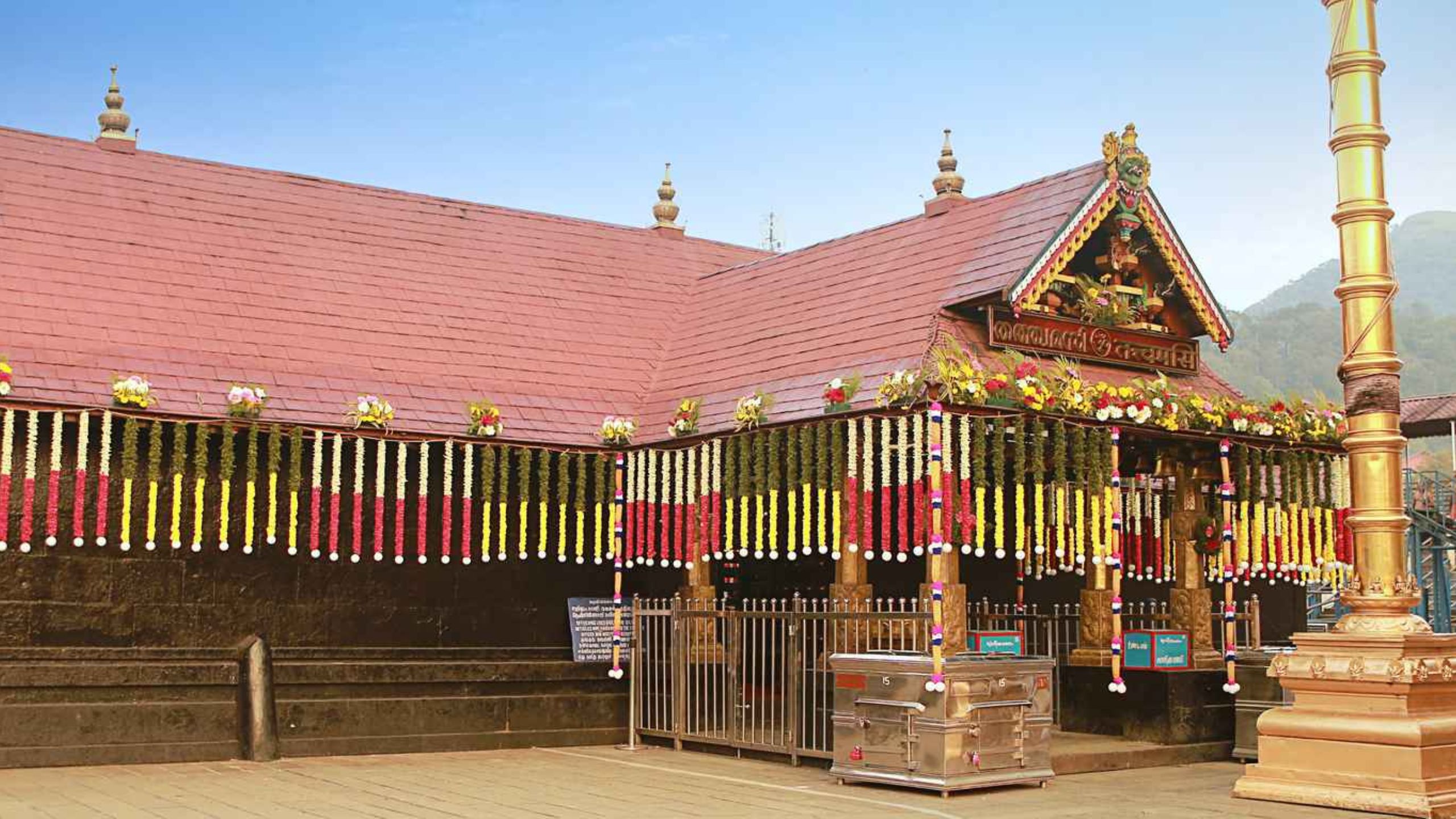Sabarimala is one of the most sacred spiritual sites in Southern Bharat. It is the home of Shri Ayyappa, the son of Mohini and Shiva. He is also known as Manikandan, Sastha, Hariharan or Dharmasastha. There are many amazing facts surrounding the Sabarimala shrine which we will explore today.
Table of Contents
Why was the temple built at Sabarimala?
Shri Ayyappa (also known as Manikandan) fulfilled his purpose of birth by slaying the demoness called Mahishi. He was only twelve years old when this event happened. He decided to leave the earth and return to Devlok. Before he left, he asked his earthly father Raja Rajashekhara to ask for a boon since he was immensely pleased with his devotion. The teary eyed king, now fully aware of Manikandan’s divine being, expressed his wish to build a temple in Manikandan’s memory. He asked Manikandan to suggest a place/site to build this temple. Manikandan aimed and shot an arrow which fell at a place called Shabari. He instructed the king to build the temple in that place and then left. Sabarimala means ‘hill of Sabari’.

The connection with Shri Ram
Shabari is mentioned in Ramayan. She was a devotee of Shri Ram. As per legend, Shabari met Rishi Matang near the base of Mount Rishyamukha. She became his disciple and served him with immense devotion for years.
When Rishi Matang was on his deathbed, he foretold that Shri Ram would come to give Shabari darshan. He told her to wait for the arrival of Shri Ram. Since that time, Shabari only left her ashram each day to gather berries for Shri Ram. She would pick one, taste it, and place it in her basket if it was sweet. She discarded the bitter berries because she wanted to give only sweet berries to Shri Ram.
Shri Ram visited Shabari at her ashram while on his journey to find Maa Sita. She fed him the sweet berries that she had collected. That time Shri Ram saw a divine person doing penance and asked Shabari who he was. Shabari told him that he was Sastha (Ayyappa) or Manikandan. Shri Ayyappa also greeted Shri Ram.
The 18 steps at Sabarimala temple
Inside the temple complex there are 18 steps which the devotees have to climb to visit Shri Ayyappa. These 18 holy steps have a spiritual significance.
The first 5 steps represent the ‘Panchendriyas’ (five human senses) namely sight, hearing, touch, smell and taste.
The next 8 steps represent ‘Ashtaragas’ namely Kama (desire), Krodh (anger), Lobha (greed), Moha (attachment), Madha (pride), Matsarya (unhealthy competition), Asuya (jealousy) and Dhumb (braggy).
The next 3 steps are the ‘Trigunas’ (three qualities) of Satva, Rajas and Tamas. The final 2 steps are Vidya (Knowledge) and Avidya (Ignorance of knowledge). One who crosses all the 18 steps becomes purified and attains the darshan of Shri Ayyappa.
The making of Shri Ayyappa idol
Raja Rajshekhar laid the foundation stone of the temple at Sabarimala under the guidance of Rishi Agastya. In due course, Raja Rajshekhar completed the construction of the Sabarimala temple alongwith the 18 holy steps. The king was now thinking of how to get the idol of Shri Ayyappa made.
Shri Ayyappa sent Parshuram for this purpose. Parshuram carved the idol of Shri Ayyappa and installed it in the Sabarimala temple on the day of Makar Sankranti.
The significance of Makar Jyothi
Makar Jyothi is a light which appears in the sky at Sabarimala on Makar Sankranti. Devotees believe that the light symbolises Shri Ayyappa’s presence and blessings. It is believed that Shri Ayyappa returns to the Earth on Makar Sankranti day to bless his devotees.
The Malikapurathamma Temple

Just 100 meters away from the Sabarimala temple is the temple of Malikapurathamma. As per legend, Mahishi was cursed to be a rakshasin (demoness). She was actually the avatar of Saraswati, Lakshmi and Parvati and was known as ‘Leela’. Dattatrey had cursed her to become a rakshasin (demoness). When Mahishi was killed by Manikandan the curse was reversed. A beautiful damsel emerged who asked Shri Ayyappa to be her consort. Shri Ayyappa declined, as he was to be a brahmachari (celibate) for the purpose of Dharma Sasan. However he said that as she was the avatar of the three goddesses – Saraswati, Lakshmi and Parvati, she would be worshipped. From that day she was called Malikapurathamma and is also worshipped.
Vavar and Erumely
Vavar was a Muslim acquaintance of Shri Ayyappa. He became a messenger for Shri Ayyappa and helped him in the wars of the mountainous region. Over time he transformed into a devotee of Shri Ayyappa and came to be known as ‘Vavar swami’.
There is a shrine dedicated to Vavar swami in Sabarimala. As per Islamic teachings there is no idol, but just a carved stone slab that symbolises the deity of Vavar. A green coloured silk cloth is hung across one of the three walls. The fourth side is open. An old sword is also kept near the wall. The main offering to Vavar is black pepper. A Muslim priest still performs the rituals today as he was a Muslim.

Image credit: https://www.keralatourism.org/destination/erumeli-vavar-mosque/213
It is believed that Shri Ayyappa appeared in the dreams of a king of Pandalam and instructed him to build a mosque for Vavar. This mosque stands today in the town of Erumely, 50 kms away from Sabarimala. Every year, devotees of Shri Ayyappa visit the mosque and pay their respects before starting the journey to Sabarimala.
Erumely is also important for one more reason. According to legend, Manikandan killed the rakshasin Mahishi at Erumely. He mounted on Mahishi’s chest and performed the spiritual dance which echoed through the Earth and Devlok ultimately killing her.
Preparation and packing of ‘Irumudi Kettu’

‘Irumudi Kettu’ is prepared under the guidance of a guru swami. Only those who carry the ‘Irumudi kettu’ on the head are allowed to climb the 18 sacred steps to the temple, as they are the ones considered to have observed the austerities and are thus eligible to climb the holy steps. Other devotees have to resort to a different passage to reach in front of the sanctum for worship.
After the initial prayers, the sacred offering of ghee (cow’s butter) is filled inside a coconut, the fibrous covering of which is removed. The draining of the water within the coconut through a small hole on the top and filling it with ghee is a symbolic act. It signifies the draining out of worldly attachments from the mind and filling it with spiritual aspirations.
Coconut is called ‘thenga’ in Malayalam and now the ghee-filled coconut, an offering for Lord Ayyappa, is known as the neyy-thenga. First, the front compartment of the bag will be filled in with the neyy-thenga and other sacred offerings to Lord Ayyappa and the accompanying deities. The front compartment is now closed by tying it with a string. The filled in front compartment is believed to be vibrant with spiritual power. Then the other compartment is filled with a few coconuts to be broken at various holy spots.
The front compartment can be opened only at Sabarimala. The ghee filled coconut represents the devotee himself who is carrying it. It is said that the coconut represents ones body and the ghee ones soul. Devotees offer the ghee to Shri Ayyappa and put the empty coconut in the burning fire.
Sabarimala yatra
The Sabarimala Yatra is not an easy one. Shri Ayyappa has set rules for devotees to follow before they become eligible to get his darshan. All devotees have to undergo a strict 41 day penance called ‘Mandala Vratham’.
They have to observe a fast for 41 days. The penance includes staying away from all worldly pleasures, physical pleasures, family ties and living like a celibate. Devotees have to walk miles on foot, bathe in the holy Pampa river and then climb the 18 holy steps of the Sabarimala temple with the ‘Irumudi Kettu’ on their heads. The devotees then accept ‘prasad’ or the Lord’s food offerings and descend the 18 steps, walking backwards, with their faces turned towards Shri Ayyappa.
Black is the recommended clothing colour during the ‘Vrathum’ period as it denotes detachment from material things. Cutting hair, shaving off facial hair, and cutting nails are forbidden. Devotees must also avoid shoes and slippers and walk bare footed. The idea is to develop discipline and healthy practices and make it a habit.
Millions of devotees visit Sabarimala every year, irrespective of caste or creed. There is a massive gathering of devotees for darshan especially during the months of November to January. It is one of the most important spiritual places in Southern Bharat.



